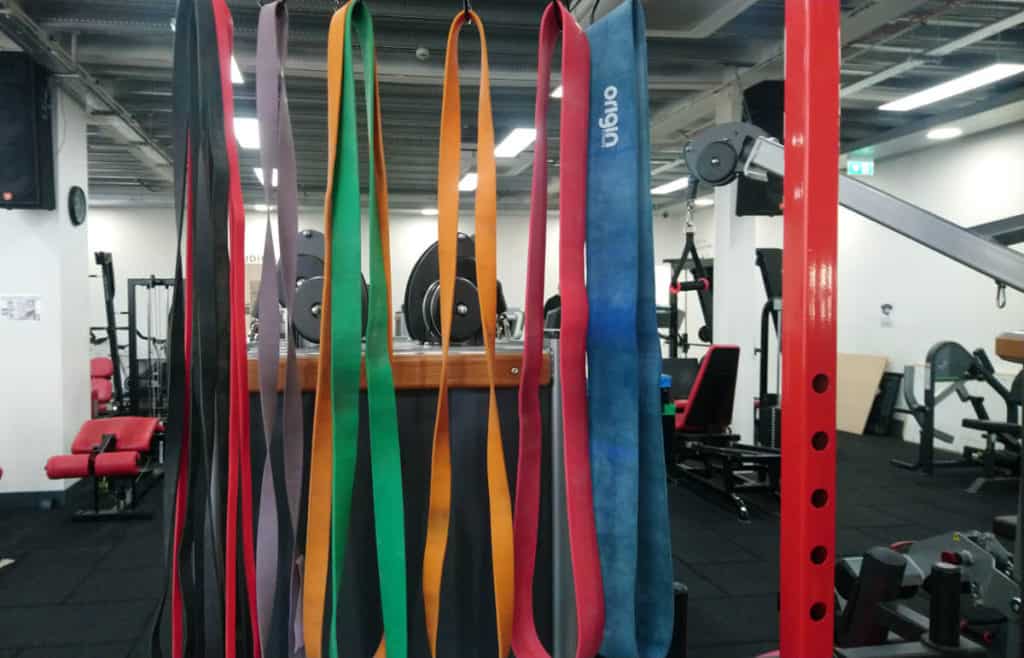Resistance bands are strong pieces of elastic that exercisers use to add a little resistance to their exercise program. Which in turn enables them to enjoy a more intense experience. Everything you do with a resistance band is a little tougher and therefore, you work a little harder to get the results you want.
So, should you use resistance bands every day? Most experts agree that the answer to this question is no, you should not. Most exercise experts agree that these bands should not be used more than two to three times per week.

What Are Resistance Bands?
Visit any online or brick-and-mortar sporting goods store, and you’ll likely find a variety of resistance bands of all sizes and colors. Online stores tend to have a wider variety of resistance bands and often have lower prices. This is your best option if you’ve never purchased these bands before.
Resistance bands are usually tubular or flat in design and come in many styles. You can find one that is made with handles for your upper-body workouts and one that comes with ankle cuffs in case you’d like to give your lower body a great workout.

These bands come in a host of eye-catching colors such as green, blue, red, yellow, and even various neon colors. Most resistance bands are very reasonably priced and, therefore, you can even purchase several of them without breaking your budget. Best of all, you don’t have to work out with them for long to experience amazing results.
Indeed, because they provide extra resistance and make you work a little harder than you normally would. You won’t need to exercise with resistance bands for more than 20 to 30 minutes at a time to get the results you were hoping for. Resistance bands are lightweight, but very powerful workout tools, helping you make the absolute most of your time in the gym.
Best of all, because of their flexibility, resistance bands can be brought with you if you travel a lot because they take up very little room inside a suitcase. That’s right – you can even exercise with resistance bands when you’re on the road!
What Advantages Do Resistance Bands Provide?
By now, you’ve realized that using resistance bands provides for a much more efficient workout every time, but why is this so? For starters, using resistance bands is simple regardless of your age and fitness level because they are merely long, thin pieces of stretchable rubber and, therefore, easy to use.
If you’re used to lifting weights, you can get roughly the same results by switching to resistance bands, because using these bands is not unlike exercising while using weights. If you’re into lifting heavy weights, a resistance band would not provide you with the same results
Resistance bands can really help you with eccentric training. If you would like to know about eccentric training check out my article Understanding Eccentric Training – Negative Reps and How to Perform Them.
You don’t even have to change up your routine just because you decide to add resistance bands to your exercise regimen. You can essentially do everything you’re doing now and simply add the resistance bands to the routine. It’s that simple!
Using resistance bands is also good because they:
- Can be used singly or in multiples of two or three for even better results
- Are great for a variety of exercises you used to do with weights
- Can help you target underused and isolated muscles for a better workout
Resistance bands also help you develop your stamina and flexibility because they work for several muscle groups at one time. And let’s face it; you’re always going to get a better overall workout when you decide to add resistance bands to the equation.
How Are Resistance Bands Used?
If you’ve ever seen resistance bands in a store, you’ve likely wondered exactly how to use them. The good news is that these bands are easy to use and very efficient, and they can be used in a variety of ways. Two of the most important ways to use resistance bands include:
- Place the end of the band under your feet and grab onto the handles with your fingers facing up; next, lift the bands as you would dumbbells and feel the resistance as you “lift” each repetition
- Lie on the floor and place your feet through the ankle cuffs and your hands on the other end; next, raise your legs up and down to work your abdominal muscles
If you feel like you need to do sit-ups, but you’re afraid it might hurt your back, resistance bands are perfect because the pressure will be taken off the back and placed mostly from the bands themselves. Because you can benefit from simply adding resistance bands to your current workout routine, they are some of the easiest ways to enhance the results of your exercise program.
Both resistance training and weight training work because they do a great job of building up muscle mass. When you use weights, the resistance is provided by gravity. In the case of resistance bands, the resistance is provided by the elasticity of the bands themselves.
Considering all these facts, it is easy to understand why using resistance bands for 20 to 30 minutes at a time. Two or three times a week can provide you with the effects you’re looking for.
Are There Different Types of Resistance Bands?
Just like dumbbells and barbells, resistance bands come in many different types and sizes. Most, however, can be included in six different categories:
1. Figure 8 Bands
These bands are made to train the upper body and are around 20 inches in length; they are made with two plastic handles that are connected with a tube-like band, making the figure 8 position
2. Lateral Resistance Bands
Instead of handles, these bands have Velcro cuffs and usually measure around 12 inches in length; they are designed to exercise the lower body. You wrap each cuff around your ankle, which provides for a great hip and thigh workout
3. Mini Bands
Also known as fit loop bands. These can measure anywhere from four inches to two feet in length and have a flat surface; they are specifically designed to exercise the lower body and make a complete loop
4. Ring Resistance Bands
Tube-shaped and only around 12 inches long, these resistance bands are designed to exercise the lower body and have two handles attached by a small, single ring; their handles are softer than other types of resistance bands, and they are made for different exercises than are other types of bands
5. Therapy Bands
These bands are usually used for some type of rehabilitation and are usually around four feet in length; they have a flat surface and can be used for both physical and even mental rehabilitation.
6. Tube Bands
Also called compact resistance bands, these bands are usually around four feet long and have handles at both ends; they are shaped like a tube (hence their name) and are used to exercise the lower body, upper body, and the arms
Once you become familiar with the basic types of resistance bands, you can then decide how to get started using them. Keep in mind that any workout can be greatly enhanced by simply adding these to your routine. Each type of band will produce different results, so you first must know which effects you’re aiming for.
Getting Started the Easy Way
If you’re intimidated by the thought of using resistance bands, not worry because there are ways to make your transition to this type of exercise a lot easier. Like any other exercise, you should always warm up first with some stretching and maybe even a few minutes of jogging on a treadmill.
If you are a beginner, you can use a higher level of resistance. Why? Because a resistance band will always bear the weight of your body. And higher bands bear more weight and, therefore, will give you a little more assistance during your exercise. In other words, your exercise is made easier with a higher-resistance band!
You should use a heavier band if you’re a beginner, and also if you’re on the overweight side. At this point, it is always a good idea to check the description on the packaging because it will tell you how much weight the resistance band can accommodate. Wider and heavier bands, however, always provide more support for your body and, therefore, are much better for beginners.
In addition, many manufacturers of resistance bands use a color-coded system that allows you to choose which level of difficulty you want to exercise with, and those colors usually follow this guideline:
- Yellow and red bands: light to medium resistance
- Green, blue, black, gold, and silver bands: medium to heavy resistance
Not all brands use the same colors, of course. As a general rule, the lighter the color, the less resistance it provides.
Conclusion
Resistance bands are a great way to add a little oomph to your current exercise routine. They can be used to increase the intensity level of the exercise. The bands are perfect even for beginners. And all you have to do to remain safe while using them is to read the instructions thoroughly and make sure you don’t use them incorrectly.
I like to use resistance bands in my workouts, they help make it a little bit harder. I’m all for making my workouts harder and challenging.



